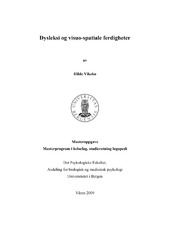Dysleksi og visuo-spatiale ferdigheter
Master thesis
Permanent lenke
https://hdl.handle.net/1956/4878Utgivelsesdato
2009-05-25Metadata
Vis full innførselSamlinger
Sammendrag
The aim of this study was to investigate the correspondence between visuo-spatial skills and emergent literacy at a later stage. In the chapter ”Theory and empirical data”, dyslexia is described on the basis of the four levels in Morton and Friths (1997) model of development. Research focusing on the relationship between dyslexia and visual factors is also presented here. A short description of the procedures and possible weaknesses concerning the study is given in the “Method” section. Information from a questionnaire that was given to parents and pre-school teachers of a sample five-year-old children (n=109) was used to calculate an at-risk index for developing dyslexia. Then, an at-risk group of 25 children and a control group of 24 children was found. The children were tested in a variety of cognitive skills when they were six and seven years old, among others visuo-spatial skills. At the age of eight years their skills in single word reading and spelling were assessed. The data were analyzed in both a prospective and a retrospective perspective. Prospectively, T-tests showed that the children at risk of developing dyslexia had weaker visuo-spatial skills measured with the Rey Complex Figure Test (RCFT) than their peers at six and seven years of age. Retrospectively, the results of the reading- and spelling tests showed that the children with the lowest spelling scores also had the lowest scores in the RCFT at six and seven years of age. The correlation analyses showed significant correlation between visuo-spatial skills and the literacy scores, especially in terms of spelling. In the light of this study there is reason to argue that visual factors play a role in dyslexia, and consequently be taken into account as to early detection, assessment and teaching methods. Formålet med denne studien har vært å vurdere hvorvidt visuo-spatiale ferdigheter har en sammenheng med tidlige lese- og skriveferdigheter på et senere tidspunkt. Opplysninger fra et spørreskjema som ble gitt til foreldre og barnehageansatte til et utvalg fem år gamle barn (n=109) ble brukt som utgangspunkt for å kalkulere en risikoindeks for å utvikle dysleksi. På bakgrunn av dette ble det dannet en risikogruppe på 25 barn og en kontrollgruppe på 24 barn. Barna ble testet i ulike kognitive ferdigheter ved seks og syv år, deriblant visuo-spatiale ferdigheter. Ved åtte ble ferdigheter i ordavkoding og staving vurdert. Dataene ble analysert både ut fra et prospektivt og et retrospektivt perspektiv. Prospektivt viste T-tester at barna i risikosonen for å utvikle dysleksi hadde svakere visuo-spatiale ferdigheter målt med Rey Complex Figure Test (RCFT) enn sine jevnaldrende ved seks og syv år. Retrospektivt viste resultatene fra lese- og stavetestene ved åtte år at barna som skårte lavest i staving også hadde de svakeste resultatene på RCFT ved seks og syv år. Korrelasjonsanalysen viste at svake visuo-spatiale ferdigheter korrelerer signifikant med lese- og skriveferdigheter, spesielt i forhold til orddiktat. På bakgrunn av denne studien er det derfor grunn til å hevde at visuelle faktorer spiller en rolle i utvikling av dysleksi, og at dette burde få kliniske implikasjoner både i forbindelse med tidlig påvisning, dysleksiutredning og undervisningsmetoder.
Utgiver
The University of BergenOpphavsrett
Copyright the author. All rights reservedThe author
